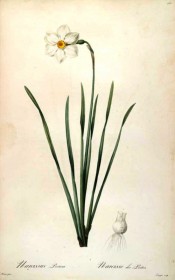Narcissus poeticus L. subsp. radiiflorus (Salisb.) Baker
See Narcissus poeticus L. for a detailed description of the species. The leaves of radiiflorus are narrower than the species with a more erect crown. [Hortus]. Burbidge describes Narcissus angustifolius as similar to radiiflorus but with a slightly different flower. Other plants given here as synonyms also vary slightly from the type.
Horticultural & Botanical History
The first detailed botanical description appears to be that in Curtis’s Botanical Magazine in 1792 as Narcissus angustifolius although there is some doubt here [[BM t.193/1792]. The name by which it is generally known today was proposed by Baker in 1888 [Baker Am. p.12/1888].
Narcissus poeticus L. var. radiiflorus is probably the plant figured as Narcissus gracilis in the Botanical Register. [BR f.816/1824]. ‘[Narcissus radiiflorus] grows wild in the moist sub-alpine meadows of Switzerland, and will thrive in any border that is not very dry indeed; it flowers here in April, a little before the following [Narcissus poeticus], which having also rather narrow leaves, is often confounded with it, and they are both charmingly fragrant.’ [THS vol.1 p.365/1805-1812].
According to Johnson's Dictionary, Narcissus angustifolius was introduced to Britain in 1570, although it should be noted that a number of forms of narcissus have been given the names listed here as synonyms. Curtis’s Botanical Magazine attempts to clarify the confusion, proposing the names angustifolius, majalis and biflorus be adopted for different forms. [BM t.193/1792]. The plant figured here as Narcissus angustifolius seems to be Narcissus poeticus, the ‘Pheasant’s eye narcissus’, while the plant figured at BM t.78/1789 appears to be the plant identified in these notes as Narcissus x odorus L., which see. Redouteé L pl.160/1802-15.
History at Camden Park
Listed in all published catalogues [B.334/1843].
Notes
The Royal Horticultural Society’s Botanical names in the genus Narcissus considers Narcissus radiiflorus Salisb. to be a valid species. I have included it here as a variety of Narcissus poeticus L., following J. G. Baker, for ease of comparison with other Narcissi listed in the Hortus.
Hortus Second describes Narcissus gracilis as having grass-like foliage and lemon-yellow flowers with a deeper yellow corona. This plant is almost certainly Hermione tegulaeflora of Salisbury, Narcissus juncifolius of Clusius. ‘This is a truly natural plant, and grows wild in Rovergue, from whence the bulbs were sent to L’Ecluse by Monsieur Le Venier. It is extremely hardy, and will succeed in any soil, but in deep loam almost every peduncle is biflorus, and it often ripens its seed. [THS vol.1 p.363/1805-1812].
Most of the Narcissi grown in gardens in the 18th and 19th centuries and graced with specific names are, in reality, hybrids or varieties of only a handful of species. John Lindley alluded to this in discussing Narcissus gracilis: ‘We are obliged to Mr. Sabine for pointing out to us the differences between this Narcissus and N. tenuior. From that gentleman's observations, it appears to be the latest in flower of all the kinds, except the late varieties of N. poeticus; to be a taller plant than N. tenuior, with a rounded, not compressed, and nearly two-edged, scape, and with pale yellow, unequally spreading, petals. But, while we assent to the propriety of considering the differences which have been mentioned sufficient to entitle a plant to be called a species, so long as others, which have been described by modern Botanists, continue to be admitted as such, we cannot avoid stating our opinion, that the whole genus Narcissus requires to be revised with a judicious, but severe, hand. It may then be discovered, that the number of genuine species is very few; and that the individuals which it has become the fashion to call species, are varieties capable of being so distinguished. This, we have reason to know, is also the opinion of Mr. Sabine, who has probably examined a greater number of plants of this genus than any other person. It will also, we think, be decided, that, in most instances, Mr. Haworth's genera are the species, and such of the same ingenious writer's species as can be distinguished from each other the varieties of Narcissus.’ [BR f.816/1824].
Published May 17, 2009 - 04:27 PM | Last updated Jul 31, 2012 - 04:58 PM
| Family | Amaryllidaceae |
|---|---|
| Category | |
| Region of origin | Southern Europe |
| Synonyms |
|
| Common Name | Sweet-scented jonquil, Great jonquil |
| Name in the Camden Park Record | Narcissus angustifolius
|
| Confidence level | medium |
